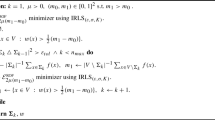Abstract
Features computed as statistics (e.g. histograms) of local filter responses have been reported as the most powerful descriptors for texture classification and segmentation. The selection of the filter banks remains however a crucial issue, as well as determining a relevant combination of these descriptors. To cope with selection and fusion issues, we propose a novel approach relying on the definition of the texture-based similarity measure as a weighted sum of the Kullback–Leibler measures between empirical feature statistics. Within a supervised framework, the weighting factors are estimated according to the maximization of a margin-based criterion. This weighting scheme can also be considered as a filter selection method: texture filter response distributions are ranked according to the associated weighting factors so that the problem of selecting a subset of filters reduces to picking the first features only. An application of this similarity measure to texture recognition is reported. We also investigate its use for texture segmentation within a Bayesian Markov Random Field (MRF)-based framework. Experiments carried out on Brodatz textures and sonar images show that the proposed weighting method improves the classification and the segmentation rates while relying on a parsimonious texture representation.









Similar content being viewed by others
References
Randen T (1997) Filter and filter bank design for image texture recognition. Thesis Report, Norwegian University of Science and Technology, Stavanger College
Randen T, Husoy J (1999) Filtering for texture classification: a comparative study. IEEE Trans Pattern Anal Mach Intell 21(4):291–310
Kashyap RL (1984) Characterization and estimation of two-dimensional ARMA models. IEEE Trans Inf Theory 30:736–745
Ohanian PP, Dubes RC (1992) Performance evaluation for four class of texture features. Pattern Recognit 25(8):819–833
Conners RW, Harlow CA (1980) A theoretical comparison of texture algorithms. IEEE Trans Pattern Anal Mach Intell 2(3):204–222
Strand J, Taxt T (1994) Local frequency features for texture classification. Int Conf Pattern Recognit 27(10):1397–1406
Sharma M, Singh S (2001) Evaluation of texture methods for image analysis. In: 7th Australian and New Zealand intelligent information systems conference, pp 117–121
Singh M, Singh S (2002) Spatial texture analysis: a comparative study. Int Conf Pattern Recognit 1:676–679
Clausi A, Deng H (2004) Feature fusion for image texture segmentation. Int Conf Pattern Recognit 1:580–583
Haralick R (1979) Statistical and structural approaches to texture. Proc IEEE 67(5):786–804
Xiuwen L, DeLiang W (2003) Texture classification using spectral histograms. IEEE Trans Image Process 12(6):661–670
Cula OG, Dana K (2003) 3D texture recognition using bidirectional feature histograms. IEEE Trans Pattern Anal Mach Intell 25(12):1619–1624
Nammalwar P, Ghita O, Whelan PF (2005) Integration of feature distributions for color texture segmentation. Conf Pattern Recognit 1:716–719
Xu Q, Yang J, Ding S (2004) Texture segmentation using LBP embedded region competition. Electron Lett Comput Vis Image Anal 5(1):41–47
Fablet R, Bouthemy P (2003) Motion recognition using nonparametric image motion models estimated from temporal and multiscale cooccurrence statistics. IEEE Trans Pattern Anal Mach Intell 25(12):1619–1624
Zhu XLSC, Wu Y (1998) Filters, random fields and maximum entropy (frame): toward a unified theory for texture modeling. Int J Comput Vis 27(2):107–126
Gimel’farb G (1996) Texture modeling by multiple pairwise pixel interactions. IEEE Trans Pattern Anal Mach Intell 18(11):1110–1114
Jain A, Farrokhania F (1991) Unsupervised textures segmentation using gabor filters. Pattern Recognit 24(12):1167–1186
Chang T, kuo C (1993) Texture analysis and classification with tree-structured wavelet transform. IEEE Trans Image Process 2(4):429–441
Kullback S (1959) Information theory and statistics. Wiley, New York
Parzen E (1962) On the estimation of a probability density function and the mode. Ann Math Stat 33:1065–1076
Kohavi R, John G (1997) Wrappers for feature subset selection. Artif Intell 97(12):273–324
Marroquin J, Mitter S, Poggio T (1987) Probabilistic solution of ill-posed problems in computational vision. J Am Stat Assoc 82:76–89
Geman S, Geman G (1984) Stochastic relaxation, Gibbs distributions and the Bayesian restoration of images. IEEE Trans Pattern Anal Mach Intell 6(6):721–741
Besag J (1986) On the statistical analysis of dirty pictures. J R Stat Soc Ser B 48:259–302
Pieczynski W (1992) Statistical image segmentation. Mach Graph Vis 1(2):261–268
Duda RO, Hart PE (1973) Pattern classification and scene analysis. Wiley, New York
Brodatz P (1966) Textures: a photographic album for artists and designers. Dover, New York
Jensen CA, El Sharkawi MA, Marks RJ (2001) Power system security assessment using neural networks: feature selection using Fisher discrimination. IEEE Trans Power Syst 16(4):757–763
Lianantonakis M, Petillot YR (2005) Sidescan sonar segmentation using active contours and level set methods. In: Conference proceedings OCEANS ’05. 1:719–724
Ehrhold A, Hamon D, Guillaumont B (2006) The Rebent monitoring network, a spatial integrated acoustic approach to survey nearshore macrobenthic habitats: application to the bay of Concarneau (South Brittany, France). ICES J Mar Sci 63:1604–1615
Kira K, Rendell L (1992) A practical approach to feature selection. Proc Int Conf Mach Learn 1:249–256
Robnik-Sikonja M, Kononenko I (2003) Theoretical and empirical analysis of ReliefF and RReliefF. J Mach Learn Res 53(1-2):23–69
Gilad-Bachrach R, Navot A, Tishby N (2004) Margin based feature selection—theory and algorithms. ACM Int Conf Proc Ser 69:43
Author information
Authors and Affiliations
Corresponding author
Rights and permissions
About this article
Cite this article
Karoui, I., Fablet, R., Boucher, JM. et al. Fusion of textural statistics using a similarity measure: application to texture recognition and segmentation. Pattern Anal Applic 11, 425–434 (2008). https://doi.org/10.1007/s10044-008-0108-z
Received:
Accepted:
Published:
Issue Date:
DOI: https://doi.org/10.1007/s10044-008-0108-z




